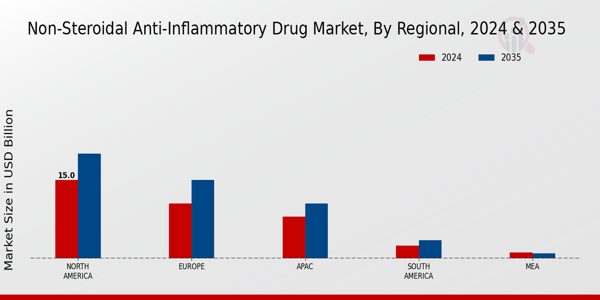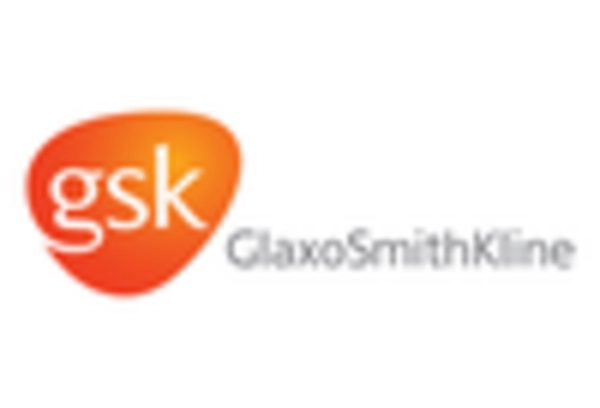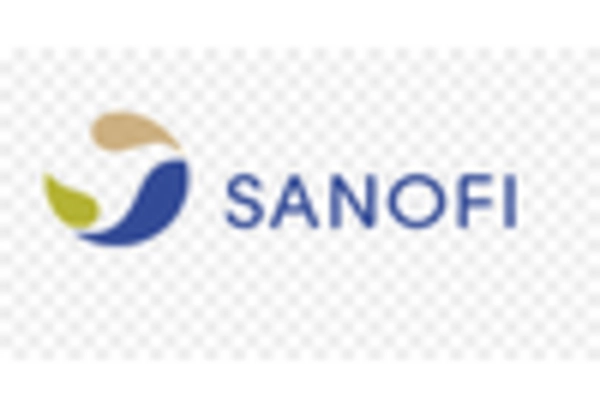Regulatory Support and Market Accessibility
Regulatory support plays a crucial role in shaping the Non-Steroidal Anti-Inflammatory Drug Market. Governments and health authorities are increasingly recognizing the importance of NSAIDs in pain management, leading to streamlined approval processes for new formulations. This regulatory environment fosters innovation and encourages pharmaceutical companies to invest in research and development. Additionally, the accessibility of NSAIDs over-the-counter in many regions enhances their availability to consumers, further driving market growth. As regulatory frameworks continue to evolve, the Non-Steroidal Anti-Inflammatory Drug Market is likely to benefit from increased competition and a wider range of product offerings, ultimately improving patient access to effective pain relief solutions.
Rising Awareness of Pain Management Options
There is a notable increase in awareness regarding pain management options, which is positively influencing the Non-Steroidal Anti-Inflammatory Drug Market. Patients are becoming more informed about their treatment choices, leading to a greater demand for NSAIDs as a first-line therapy for pain relief. Educational campaigns and healthcare provider initiatives are contributing to this trend, emphasizing the importance of managing pain effectively. As a result, the market for NSAIDs is likely to see a surge in usage, as patients seek alternatives to more invasive treatments. This heightened awareness not only benefits patients but also encourages pharmaceutical companies to innovate and expand their NSAID offerings, further stimulating the Non-Steroidal Anti-Inflammatory Drug Market.
Aging Population and Associated Health Issues
The demographic shift towards an aging population is a significant driver for the Non-Steroidal Anti-Inflammatory Drug Market. As individuals age, they are more susceptible to various health issues, including arthritis and other inflammatory diseases. Data indicates that by 2030, the number of individuals aged 65 and older will reach approximately 1.4 billion, leading to a higher demand for NSAIDs. These drugs are often utilized to manage pain and inflammation associated with age-related conditions, making them a staple in geriatric care. The growing elderly population, coupled with the need for effective pain management solutions, suggests that the Non-Steroidal Anti-Inflammatory Drug Market will continue to expand in response to these demographic changes.
Advancements in Drug Development and Formulation
The Non-Steroidal Anti-Inflammatory Drug Market is being propelled by advancements in drug development and formulation technologies. Recent innovations have led to the creation of new NSAID formulations that enhance efficacy and reduce side effects. For instance, the development of topical NSAIDs has provided patients with alternatives that minimize gastrointestinal risks associated with oral medications. Furthermore, the introduction of combination therapies that incorporate NSAIDs with other analgesics is gaining traction. These advancements not only improve patient outcomes but also expand the therapeutic applications of NSAIDs, thereby driving growth in the Non-Steroidal Anti-Inflammatory Drug Market. As research continues to evolve, the potential for new formulations remains a key factor in market expansion.
Increasing Prevalence of Chronic Pain Conditions
The Non-Steroidal Anti-Inflammatory Drug Market is experiencing growth due to the rising prevalence of chronic pain conditions such as arthritis, fibromyalgia, and lower back pain. According to recent data, approximately 20 percent of adults suffer from chronic pain, which drives the demand for effective pain management solutions. As healthcare providers seek to address this growing issue, the reliance on non-steroidal anti-inflammatory drugs (NSAIDs) becomes more pronounced. These medications are often preferred due to their efficacy in reducing inflammation and pain without the side effects associated with opioids. Consequently, the increasing incidence of chronic pain conditions is likely to propel the Non-Steroidal Anti-Inflammatory Drug Market forward, as patients and healthcare professionals alike seek reliable treatment options.


















Leave a Comment